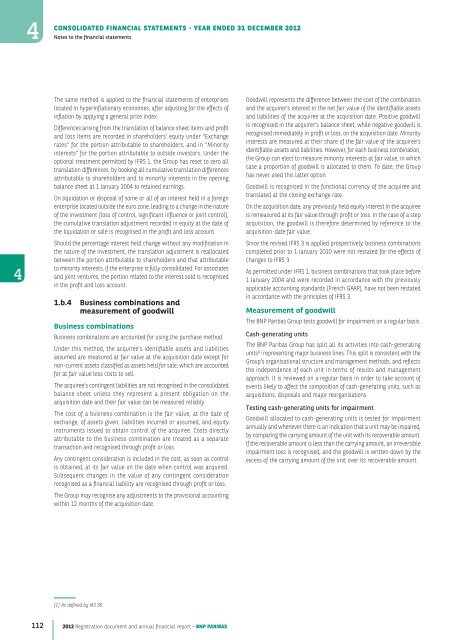2012 Registration document and annual financial report - BNP Paribas
2012 Registration document and annual financial report - BNP Paribas
2012 Registration document and annual financial report - BNP Paribas
- No tags were found...
You also want an ePaper? Increase the reach of your titles
YUMPU automatically turns print PDFs into web optimized ePapers that Google loves.
4CONSOLIDATEDFINANCIAL STATEMENTS - YEAR ENDED 31 DECEMBER <strong>2012</strong>Notes to the <strong>financial</strong> statements4The same method is applied to the <strong>financial</strong> statements of enterpriseslocated in hyperinflationary economies, after adjusting for the effects ofinflation by applying a general price index.Differences arising from the translation of balance sheet items <strong>and</strong> profit<strong>and</strong> loss items are recorded in shareholders’ equity under “Exchangerates” for the portion attributable to shareholders, <strong>and</strong> in “Minorityinterests” for the portion attributable to outside investors. Under theoptional treatment permitted by IFRS 1, the Group has reset to zero alltranslation differences, by booking all cumulative translation differencesattributable to shareholders <strong>and</strong> to minority interests in the openingbalance sheet at 1 January 2004 to retained earnings.On liquidation or disposal of some or all of an interest held in a foreignenterprise located outside the euro zone, leading to a change in the natureof the investment (loss of control, significant influence or joint control),the cumulative translation adjustment recorded in equity at the date ofthe liquidation or sale is recognised in the profit <strong>and</strong> loss account.Should the percentage interest held change without any modification inthe nature of the investment, the translation adjustment is reallocatedbetween the portion attributable to shareholders <strong>and</strong> that attributableto minority interests, if the enterprise is fully consolidated. For associates<strong>and</strong> joint ventures, the portion related to the interest sold is recognisedin the profit <strong>and</strong> loss account.1.b.4Business combinations <strong>and</strong>measurement of goodwillBusiness combinationsBusiness combinations are accounted for using the purchase method.Under this method, the acquiree’s identifiable assets <strong>and</strong> liabilitiesassumed are measured at fair value at the acquisition date except fornon-current assets classified as assets held for sale, which are accountedfor at fair value less costs to sell.The acquiree’s contingent liabilities are not recognised in the consolidatedbalance sheet unless they represent a present obligation on theacquisition date <strong>and</strong> their fair value can be measured reliably.The cost of a business combination is the fair value, at the date ofexchange, of assets given, liabilities incurred or assumed, <strong>and</strong> equityinstruments issued to obtain control of the acquiree. Costs directlyattributable to the business combination are treated as a separatetransaction <strong>and</strong> recognised through profit or loss.Any contingent consideration is included in the cost, as soon as controlis obtained, at its fair value on the date when control was acquired.Subsequent changes in the value of any contingent considerationrecognised as a <strong>financial</strong> liability are recognised through profit or loss.The Group may recognise any adjustments to the provisional accountingwithin 12 months of the acquisition date.Goodwill represents the difference between the cost of the combination<strong>and</strong> the acquirer’s interest in the net fair value of the identifiable assets<strong>and</strong> liabilities of the acquiree at the acquisition date. Positive goodwillis recognised in the acquirer’s balance sheet, while negative goodwill isrecognised immediately in profit or loss, on the acquisition date. Minorityinterests are measured at their share of the fair value of the acquiree’sidentifiable assets <strong>and</strong> liabilities. However, for each business combination,the Group can elect to measure minority interests at fair value, in whichcase a proportion of goodwill is allocated to them. To date, the Grouphas never used this latter option.Goodwill is recognised in the functional currency of the acquiree <strong>and</strong>translated at the closing exchange rate.On the acquisition date, any previously held equity interest in the acquireeis remeasured at its fair value through profit or loss. In the case of a stepacquisition, the goodwill is therefore determined by reference to theacquisition-date fair value.Since the revised IFRS 3 is applied prospectively, business combinationscompleted prior to 1 January 2010 were not restated for the effects ofchanges to IFRS 3.As permitted under IFRS 1, business combinations that took place before1 January 2004 <strong>and</strong> were recorded in accordance with the previouslyapplicable accounting st<strong>and</strong>ards (French GAAP), have not been restatedin accordance with the principles of IFRS 3.Measurement of goodwillThe <strong>BNP</strong> <strong>Paribas</strong> Group tests goodwill for impairment on a regular basis.Cash-generating unitsThe <strong>BNP</strong> <strong>Paribas</strong> Group has split all its activities into cash-generatingunits (1) representing major business lines. This split is consistent with theGroup’s organisational structure <strong>and</strong> management methods, <strong>and</strong> reflectsthe independence of each unit in terms of results <strong>and</strong> managementapproach. It is reviewed on a regular basis in order to take account ofevents likely to affect the composition of cash-generating units, such asacquisitions, disposals <strong>and</strong> major reorganisations.Testing cash-generating units for impairmentGoodwill allocated to cash-generating units is tested for impairment<strong>annual</strong>ly <strong>and</strong> whenever there is an indication that a unit may be impaired,by comparing the carrying amount of the unit with its recoverable amount.If the recoverable amount is less than the carrying amount, an irreversibleimpairment loss is recognised, <strong>and</strong> the goodwill is written down by theexcess of the carrying amount of the unit over its recoverable amount.(1) As defined by IAS 36.112<strong>2012</strong> <strong>Registration</strong> <strong>document</strong> <strong>and</strong> <strong>annual</strong> <strong>financial</strong> <strong>report</strong> - <strong>BNP</strong> PARIBAS





